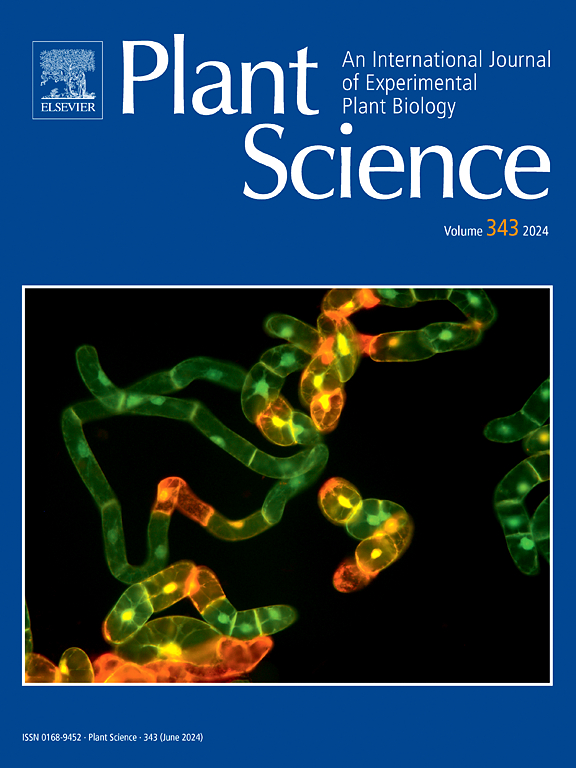A 13-bp insertion in CmAPRR2 gene disrupts its function in regulating the green rind formation of immature melon fruit (Cucumis melo L.)
IF 4.2
2区 生物学
Q2 BIOCHEMISTRY & MOLECULAR BIOLOGY
引用次数: 0
Abstract
Melon (Cucumis melo L.) fruit rind color represents a crucial agronomic trait that significantly influences consumer preference, market value, and postharvest quality. Although economically important, the molecular mechanisms regulating rind color variation remain largely unexplored. In this study, we identified and characterized a key gene controlling the immature fruit rind color from two melon inbred lines, TC3 with immature green fruit rind and Tm34 with immature light-green fruit rind. Genetic segregation analysis across multiple populations demonstrated that immature green fruit rind color is governed by a single completely dominant gene, designated as GR. Fine mapping strategies delimited the GR locus to a 27.14 kb region on chromosome 4 containing five candidate genes. Sequence analysis revealed a 13-bp insertion specifically within the seventh exon of CmAPRR2, encoding a two-component response regulator-like protein APRR2. The insertion introduced a premature stop codon, leading to a truncated protein. Allelic diversity assessment among 40 natural melon accessions revealed a strong correlation between rind color phenotype and the CmAPRR2 insertion polymorphism. Expression analysis demonstrated significantly higher CmAPRR2 transcript levels in green rinds compared to light-green rinds during immature fruit development. Consistent with this observation, genes involved in chlorophyll biosynthesis and chloroplast development were also upregulated in green rinds. While the insertion mutation did not affect the nuclear localization of CmAPRR2, it exhibited a significant reduction in its transcriptional activation capacity. Further, employing virus-induced gene silencing (VIGS) to silence the SlAPRR2 gene in tomato led to the development of light-green fruit coloration and a marked downregulation of APRR2 gene expression. These findings provide novel insights into the molecular mechanisms underlying melon rind color formation and identify CmAPRR2 as a promising genetic resource for molecular breeding programs aimed at manipulating rind color traits in melon.
CmAPRR2基因中一个13 bp的插入破坏了其调节未成熟甜瓜果实绿皮形成的功能。
甜瓜(Cucumis melo L.)果皮颜色是影响消费者偏好、市场价值和采后品质的重要农艺性状。尽管具有重要的经济意义,但调节果皮颜色变化的分子机制仍未被充分探索。在本研究中,我们从两个甜瓜自交系TC3和Tm34中鉴定并鉴定了一个控制未成熟果皮颜色的关键基因。TC3和Tm34分别为未成熟果皮为绿色和淡绿色。多个群体间的遗传分离分析表明,未成熟果皮的绿色由一个完全显性基因GR控制。精细的定位策略将GR位点定位在4号染色体上一个包含5个候选基因的27.14 kb区域。序列分析显示,在CmAPRR2的第7外显子中有一个13bp的插入,编码一个双组分响应调控蛋白APRR2。该插入引入了一个过早终止密码子,导致一个截断的蛋白质。对40份天然甜瓜材料的等位基因多样性分析表明,CmAPRR2插入多态性与甜瓜果皮颜色表型有较强的相关性。表达分析表明,在未成熟果实发育过程中,绿色果皮的CmAPRR2转录本水平明显高于浅绿色果皮。与这一观察结果一致,参与叶绿素生物合成和叶绿体发育的基因也在绿皮中上调。虽然插入突变不影响CmAPRR2的核定位,但其转录激活能力显著降低。此外,利用病毒诱导基因沉默(VIGS)对番茄SlAPRR2基因进行沉默,导致果实颜色呈现浅绿色,APRR2基因表达显著下调。这些发现为研究甜瓜果皮颜色形成的分子机制提供了新的见解,并确定了CmAPRR2是调控甜瓜果皮颜色性状的分子育种项目中有前景的遗传资源。
本文章由计算机程序翻译,如有差异,请以英文原文为准。
求助全文
约1分钟内获得全文
求助全文
来源期刊

Plant Science
生物-生化与分子生物学
CiteScore
9.10
自引率
1.90%
发文量
322
审稿时长
33 days
期刊介绍:
Plant Science will publish in the minimum of time, research manuscripts as well as commissioned reviews and commentaries recommended by its referees in all areas of experimental plant biology with emphasis in the broad areas of genomics, proteomics, biochemistry (including enzymology), physiology, cell biology, development, genetics, functional plant breeding, systems biology and the interaction of plants with the environment.
Manuscripts for full consideration should be written concisely and essentially as a final report. The main criterion for publication is that the manuscript must contain original and significant insights that lead to a better understanding of fundamental plant biology. Papers centering on plant cell culture should be of interest to a wide audience and methods employed result in a substantial improvement over existing established techniques and approaches. Methods papers are welcome only when the technique(s) described is novel or provides a major advancement of established protocols.
 求助内容:
求助内容: 应助结果提醒方式:
应助结果提醒方式:


